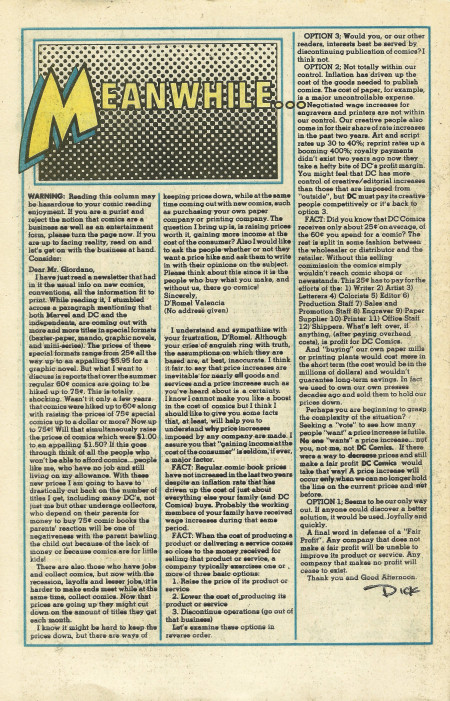“Any company that makes no profit will cease to exist.” – DC Comics, 1983
From the first issue of DC’s Power Lords comic book we find this letter and response regarding DC’s comic book pricing in 1983. I absolutely loves these peeks behind-the-scenes of business, and reading DC’s Executive Editor at the time, Dick Giordano, outline the reasons why comic prices have to increase is a real treat.
In a long letter, comic reader D’Romel Valencia wrote one line that I believe needs recognition today:
“The question I bring up is, is raising prices worth it, gaining more income at the cost of the consumer?”
Giordano’s response is fantastic, discussing how much money DC collected from each $0.60 comic sold (a quarter) and explaining that the company had to raise prices in order to continue publishing comic books. Inflation can be harsh, and the comic publishers of the age — as with, I suspect, today — only raised the cover price of a book once they had exhausted all other options.
And if D’Romel Valencia thought the cover price increasing to $0.75 he must really hate today’s $2.99 and $3.99 prices. Adjusting for inflation that $0.75 comic in 1984 would equal $1.68 today. To be fair, today’s comics sell in fewer numbers than they once did and the paper and print quality is far better than in 1983. Still, we are talking about comic prices effectively doubling (when adjusted for inflation) over the last three decades. Try not to think of it that way.

Related articles
- 1999 Coca-Cola Ad in DC Comics (battlegrip.com)
- “The Battle Action Continues with Sgt. Rock Playsets!” (battlegrip.com)
I think the double-whammy hurting comics is that as storytelling has gotten more decompressed, the cost per STORY has increased above and beyond the cost per ISSUE.
In Amazing Spider-Man #1-10 from 1963, there were TWELVE complete stories in there (cover price for all 10 issues, $1.20 — $9.20 in today’s dollars).
In comparison, the first 10 issues of the 2014 reboot has… well, it’s kind of hard to quantify. Issue #1 has 5-6 stories (depending on how you count), and the next nine issues encompass about three stories (including a crossover with the ORIGINAL SIN event), and 2/7ths of the SPIDER-VERSE event. Cover price: $41.90.
Even — to pick a 1980s example — JUSTICE LEAGUE OF AMERICA did pretty well, value-wise. Someone who bought the entire run of 1983 JLofA comics ($7.35 cover price, $17.32 today) would get five complete stories, and the start of another.
I’ve tried my darndest to instill a love of comics in our youngling, but I can’t deny his logic that there are MUCH better things to spend his allowance on. ($41.90 would buy a few days’ enjoyment for 12 issues of Amazing Spider-Man, or a new Pokemon game that he’ll be playing for over a month…)
If you want to support comic book sales in the Republic of Smarshistan, You may have to resort to a classic Big Government tactic — subsidies.
Offer to match 1-for-1 all money he spends on comics. That will encourage sales, thus supporting the publishers, distributors, and retailers.